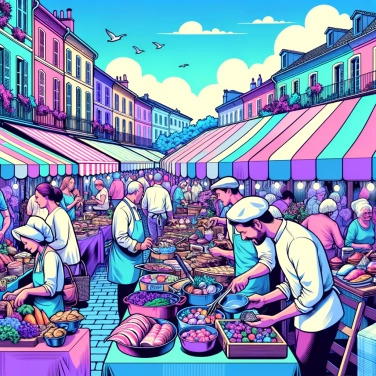Eggs can be cooked in different ways due to the variety of their chemical compositions. Cooking alters the structure of the proteins and fats in the egg, resulting in different textures and flavors.

An egg may seem simple but actually has a truly unique structure. On the outside, a porous shell made mostly of calcium carbonate protects the interior while allowing for gas exchange. Beneath that, two membranes serve as additional insulating material, keeping its precious contents safe. Next comes the egg white, or albumen, primarily composed of water and proteins, the most well-known of which are ovalbumin and lysozyme. These proteins give the egg white its ability to become solid when cooked, transitioning from a soft transparent state to the creamy or firm white that we love. At the heart of it all is the famous egg yolk, a true concentrate of energy and nutrients mainly made up of lipids, proteins, vitamins, and minerals: a real nutritional powerhouse protected by a thin membrane called the vitelline membrane. Its beautiful yellow-orange color? It mainly comes from the pigments it contains, such as carotenoids, which largely depend on the hen's diet. In short, each part of the egg has a specific chemical composition that explains why it reacts differently depending on cooking techniques.
When you heat an egg, it's mainly its proteins that come into play. Initially, these proteins swim peacefully in the water, all curled up. Heat them, and voilà, they uncoil, lose their original shape, and interact with each other: this is what we call the denaturation of proteins. Then, these same proteins start to form a solid network by binding together through heat: this is coagulation. It's this transformation that makes the egg firm rather than liquid. The yolk and the white have different proteins, which accounts for their texture differences when cooked. The yolk becomes creamy due to its fats, while the white quickly becomes firmer and opaque. If overcooked, you risk the formation of sulfur compounds (you know, that little gray-green layer around the yolk), resulting from a chemical reaction between the iron in the yolk and the sulfur in the white. Not very appetizing, but completely harmless.
Cooking an egg soft-boiled, poached, or hard changes everything, especially in terms of texture. Soft-boiled, the white remains delicately creamy, while hard-cooked, it becomes firm and slightly rubbery. If you prefer a softer result with a runny yolk, soft-boiled or poached eggs are perfect, providing a melting sensation and a lovely creamy touch. A quickly beaten omelet will give you a light and airy texture, while slow-cooked scrambled eggs produce an incomparable creamy consistency. In terms of flavor, butter, oil, or steam also make a big difference: a fried egg will have grilled and crispy flavors, while a steamed egg will have a mild and delicate taste. Even the beating affects the flavor: well mixed with butter or cream, scrambled eggs reveal their indulgent side even more. In short, the chosen method truly creates the entire taste and sensory identity of your egg.
Cooking eggs is primarily a matter of control. If you heat them too much, the whites quickly become rubbery and the yolk dries out; conversely, a lack of heat prolongs the cooking time without properly setting the egg. The temperature just right allows the proteins in the eggs to coagulate gently: around 62 °C for the whites, and about 65-70 °C for the yolks. The time spent cooking is equally important: a soft-boiled egg will be perfect at exactly 6 minutes, but if you prefer a hard-boiled egg, aim for 9 to 10 minutes instead. A few degrees or seconds too much, and the egg easily goes from delicious to "meh." A subtle balance to find and carefully maintain to achieve the exact desired texture.
The way of cooking eggs largely depends on the cultural and dietary habits of each region of the world. In France, for example, oeuf à la coque or oeuf cocotte are classics of family breakfast or brunch. In Japan, there is onsen tamago, an egg slowly cooked at very low temperatures in natural hot water, giving it a silky white and creamy yolk. In the USA and England, scrambled or fried eggs are staples of breakfast. In the Middle East and North Africa, people love eggs cooked in spicy tomato sauce, like the famous recipe called chakchouka, often enjoyed by several people directly from the dish. Each culture brings its own flavors and techniques, making the egg a universal ingredient with a thousand faces.
Overcooking scrambled eggs leads to a grainy and dry texture; it is advised to cook them slowly and at a low temperature to achieve a creamy consistency.
In some Asian countries, such as China, there is a delicacy called 'century egg,' which results from a fermentation process involving clay, ashes, and alkaline salts. In reality, it is not a century old: its total preparation time lasts from a few weeks to a few months.
Eggs have a protective inner membrane that helps maintain their freshness, which is why it is important to store them pointed end down to preserve this membrane and extend their shelf life.
The color of an egg's shell depends solely on the breed of the hen that lays it and does not influence its taste or nutritional qualities.
Scrambled eggs become dry and rubbery when cooked at too high a temperature or for too long, which causes excessive coagulation of the proteins. Cooking over low heat and gently stirring helps ensure a creamy and pleasant texture.
Salt affects the coagulation of egg proteins. Salting beforehand helps achieve a softer and more uniform texture, especially for scrambled eggs or omelets. For fried or poached eggs, it is more common to salt after cooking, allowing everyone to season according to their taste.
Here is the translation: "Submerge the egg in a container filled with cold water: if it sinks and lies flat on the bottom, it is very fresh. If it stands upright while still at the bottom, it is still edible but should be consumed soon. An egg that floats to the surface is no longer fresh and should be avoided."
No, the cooking method does not significantly affect the nutritional value in terms of protein or minerals. However, the possible use of oil or butter for frying eggs may slightly increase the caloric and fat content.
This greenish color appears due to a reaction between the sulfur in the egg white and the iron in the yolk. This mainly occurs when the eggs are cooked for too long or cooled too slowly. Good news: this phenomenon is completely harmless to health!

No one has answered this quiz yet, be the first!' :-)
Question 1/5